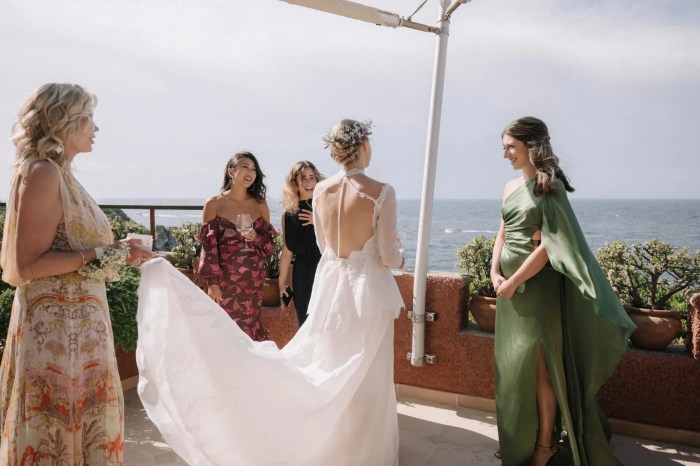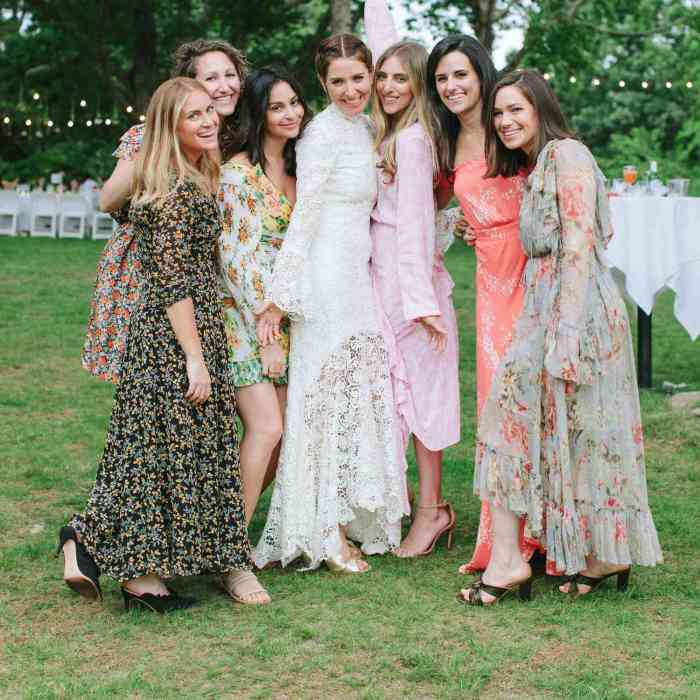
Wedding Reception Dress Styles
Wedding reception dress ideas – Choosing the perfect wedding reception dress is a crucial step in planning your special day. This section explores various dress styles, silhouettes, fabrics, and embellishments to help you find the ideal look that reflects your personal style and complements your body type.
Three Distinct Wedding Reception Dress Designs
Here are three distinct wedding reception dress designs, each showcasing a different style:
- Classic Elegance: A floor-length A-line gown in ivory silk charmeuse. The silhouette is flattering on most body types. Delicate beading accents the waistline, adding subtle sparkle. The fabric drapes beautifully, creating a sophisticated and timeless look.
- Modern Minimalism: A sleek, fitted midi dress in blush-colored crepe. The clean lines and simple silhouette create a contemporary feel. A subtle cowl neckline adds a touch of sophistication. The crepe fabric offers a smooth, elegant drape, perfect for a modern aesthetic.
- Bohemian Romance: A flowing maxi dress in ivory lace over champagne-colored silk. The lace overlay adds texture and romantic detail, while the silk underlayer provides a soft, comfortable feel. Delicate floral embroidery further enhances the bohemian charm. The loose, flowing silhouette is perfect for a relaxed and carefree vibe.
Silhouette Suitability for Different Body Types
Different silhouettes flatter different body types. Here’s a comparison:
- A-line: This universally flattering silhouette accentuates the waist and skims over the hips and thighs, suitable for most body types.
- Mermaid: This form-fitting silhouette hugs the body to the knees before flaring out, ideal for hourglass and pear-shaped figures. It may not be as flattering on those with broader shoulders or a straighter figure.
- Ballgown: This full-skirted silhouette creates a dramatic and romantic look, best suited for those who want to emphasize their upper body. It can overwhelm those with petite frames.
Advantages and Disadvantages of Fabrics
The choice of fabric significantly impacts the look and feel of your reception dress.
- Lace: Offers a romantic and delicate look, but can be delicate and require careful handling. It can also be less breathable than other fabrics.
- Tulle: Creates volume and texture, perfect for ballgowns and other voluminous styles. However, it can be prone to wrinkling and may require professional cleaning.
- Satin: Provides a luxurious and smooth look, but can be more prone to showing creases and imperfections. It can also be less forgiving on body types with curves.
Wedding Reception Dress Color Palettes and Trends
Color choices significantly impact the overall aesthetic of your wedding reception look. This section explores current trends and provides examples of unexpected color choices.
Color Palette Table
| Color Palette | Dress Style | Suitable Venue | Overall Impression |
|---|---|---|---|
| Ivory and Blush | A-line gown | Rustic barn or garden | Romantic and ethereal |
| Navy Blue and Gold | Mermaid gown | Formal ballroom or hotel | Elegant and sophisticated |
| Dusty Rose and Champagne | Flowing maxi dress | Beachfront or vineyard | Soft and romantic |
| Emerald Green and Silver | Fitted sheath dress | Modern art gallery or loft | Luxurious and glamorous |
| Deep Burgundy and Black | A-line gown with lace | Historic mansion or church | Dramatic and classic |
Current and Upcoming Trends
Current trends include muted jewel tones, rich earth tones, and unexpected pops of color. Upcoming trends suggest a move towards more sustainable and ethically sourced fabrics, with a focus on natural dyes and textures.
Unexpected Color Choices
Three unexpected yet suitable color choices include:
- Sage Green: Offers a fresh and calming feel, perfect for a spring or summer wedding.
- Burnt Orange: Adds a warm and sophisticated touch, ideal for an autumn wedding.
- Deep Teal: Provides a rich and luxurious feel, perfect for a winter wedding.
Wedding Reception Dress Accessories and Styling
Accessories play a vital role in completing your wedding reception look. The right accessories can elevate your outfit and create a cohesive style.
Accessory Sets for Different Dress Styles
Here are three accessory sets designed to complement different dress styles:
- Classic: Pearl necklace and earrings, ivory satin heels, and a small clutch.
- Modern: Statement geometric earrings, metallic block heel sandals, and a structured mini bag.
- Bohemian: Layered necklaces with natural stones, suede ankle boots, and a fringed crossbody bag.
Complementary Hairstyles and Makeup
Consider these hairstyle and makeup suggestions:
- Classic: Soft updo with a natural makeup look.
- Modern: Sleek low bun or straight hair with a bold lip.
- Bohemian: Loose waves or braids with a dewy makeup look.
Tips for Accessorizing Without Overpowering
To avoid overpowering your look, consider these tips:
- Choose one statement piece and keep the rest simple.
- Match your accessories to the color palette of your dress.
- Consider the formality of the venue when choosing accessories.
- Don’t be afraid to experiment with different styles.
- Ensure accessories are comfortable and practical.
Budget and Ethical Considerations for Your Wedding Reception Dress

Source: brides.com
Finding a beautiful and ethical wedding reception dress doesn’t have to break the bank. This section offers guidance on budget-friendly options and sustainable practices.
Resources for Affordable Dresses
Consider these options for finding affordable yet stylish wedding reception dresses:
- Online retailers specializing in affordable bridal wear.
- Consignment shops and online marketplaces selling pre-owned dresses.
- Bridal sample sales.
- Rentals services for wedding dresses.
- Local seamstresses who can create a custom dress using budget-friendly fabrics.
Pre-Owned vs. Renting
Buying pre-owned or renting a dress offers several advantages:
- Pre-owned: Cost-effective, allows you to find unique styles, and promotes sustainability.
- Renting: More affordable than buying, eliminates the need for storage, and reduces textile waste.
However, renting might limit your choices, and buying pre-owned requires careful inspection for any damage.
Ethical and Sustainable Practices
Consider these ethical and sustainable practices:
- Choose dresses made from sustainable fabrics like organic cotton or recycled materials.
- Support brands committed to fair labor practices.
- Consider having your dress altered locally instead of buying a new one.
- Donate or resell your dress after the wedding to extend its lifespan.
Wedding Reception Dress Lengths and Necklines
The length and neckline of your dress significantly impact its overall look and suitability for different venues and body types. Careful consideration of these aspects ensures a flattering and appropriate outfit.
Dress Length Appropriateness
Different dress lengths are appropriate for different settings:
- Floor-length: Suitable for formal venues like ballrooms and churches.
- Midi: Versatile and appropriate for a range of venues, from cocktail parties to garden weddings.
- Tea-length: Elegant and charming, suitable for less formal settings.
Neckline Suitability for Body Shapes
| Neckline | Suitable Body Shape |
|---|---|
| Sweetheart | Most body types, especially those with a smaller bust |
| V-neck | Elongates the neck and torso, flattering for most body types |
| Halter | Showcases the shoulders and neck, ideal for those with a broad back |
| Off-the-shoulder | Flattering for most body types, especially those with broad shoulders |
| High neck | Suitable for those who want to emphasize their collarbone and neck |
Impact of Necklines on Overall Look, Wedding reception dress ideas
Different necklines can dramatically change the overall look of a dress. A sweetheart neckline creates a romantic and feminine look, while a V-neck elongates the body. A halter neckline adds a touch of elegance and sophistication. The choice of neckline should complement your personal style and body type.
Wedding Reception Dress Fabrics and Textures
The fabric and texture of your wedding reception dress play a crucial role in determining its drape, silhouette, and overall aesthetic. Understanding the properties of different fabrics allows for informed decision-making.
Properties of Common Fabrics
Several fabrics are commonly used in wedding reception dresses, each with unique properties:
- Silk: Luxurious, drapes beautifully, and offers a subtle sheen. However, it can be delicate and expensive.
- Chiffon: Lightweight, sheer, and flows gracefully. It is often used for overlays and romantic details.
- Crepe: Drapes well, offers a slightly textured finish, and is relatively easy to care for.
- Lace: Adds a romantic and intricate touch, but can be delicate and require careful handling.
- Tulle: Creates volume and texture, particularly suitable for full skirts.
Impact of Fabric Textures on Drape and Silhouette

Source: vogue.com
The texture of a fabric significantly impacts how a dress drapes and the overall silhouette. Lightweight fabrics like chiffon create flowing, ethereal silhouettes, while heavier fabrics like crepe provide structure and shape. Textured fabrics like lace add visual interest and dimension.
Choosing the perfect wedding reception dress can be exciting! If the wedding is in the fall, you might consider the rich textures and colors often featured in a wedding guest fall dress , which can inspire your own reception look. These autumnal hues and fabrics can easily translate into a stunning reception ensemble, whether you prefer a long gown or a chic midi dress.
Ultimately, your reception dress should reflect your personal style and the overall wedding aesthetic.
Incorporating Different Textures
Different textures can be incorporated to create a multi-dimensional and visually interesting design. For example, lace appliqués can be added to a satin gown, or beaded embroidery can be incorporated onto a crepe dress. These additions enhance the visual appeal and add depth to the overall design.
Top FAQs: Wedding Reception Dress Ideas
Can I wear a wedding reception dress more than once?
Absolutely! Many reception dresses are versatile enough for other formal events.
What if my reception dress is slightly too big or small?
A skilled tailor can easily alter a dress for a perfect fit.
How far in advance should I buy my reception dress?
Ideally, 6-8 months prior to allow for alterations and potential shipping delays.
Are there specific etiquette rules for reception dress lengths?
Generally, floor-length dresses are considered most formal, while shorter lengths are appropriate for less formal receptions. Consider the venue and time of day.
What are some eco-friendly options for wedding reception dresses?
Consider renting, buying secondhand, or choosing dresses made from sustainable fabrics like organic cotton or recycled materials.